Q1. The dark reaction in photosynthesis is called
so because
Solution
Dark
reactions are called so because they do not depend on light energy, but they
depend on the products formed by the light reactions.
Q2. The carbon in CO2 is
radioactively labelled. The product in which this radioactive carbon can be
found in C3 plants is
Solution
The first
stable compound formed from fixation of CO2 in C3
plants is 3-PGA. RuBP uses CO2 to undergo carboxylation to form 2
molecules of 3-PGA with the reaction being catalysed by the enzyme RuBisCO.
Q3. Which of the following statements is not true with respect to RuBisCO in C3 plants?
Solution
RuBisCO accounts for 16% of the total chloroplast proteins and not total cellular proteins.
Q4. NADPH is generated through
Solution
NADPH is generated through PS II in non-cyclic photophosphorylation.
Q5. The Calvin cycle proceeds in three stages:
1. Reduction, during which carbohydrate is formed at the expense of the photochemically made ATP and NADPH.
2. Regeneration, during which the carbon dioxide acceptor ribulose-1, 5-bisphosphate is formed.
3. Carboxylation, during which carbon dioxide combines with rubulose-1, 5-biphosphate.
Identify the correct sequence.
Solution
The Calvin cycle is divided into three phases. The first phase is carboxylation where RuBP is converted to two 3-carbon compounds. The next phase is reduction where ATP and NADPH are used for the synthesis of sugars. The final phase is regeneration where RuBP is regenerated for continuity of the cycle.
Q6. Structurally, chlorophyll a and b are different as
Solution
Chl a has a methyl group (-CH3) and Chl b has an aldehyde group (-CHO) in its structure.
Q7. Read the following four statements A, B, C and D, and select the right option having both correct statements.
Statements:
(A) Z scheme of light reaction occurs in the presence of PS I only.
(B) Only PS I is functional in cyclic photophosphorylation.
(C) Cyclic photophosphorylation results in the synthesis of ATP and NADPH2.
(D) Stroma lamellae lack PS II as well as NADP.
Solution
In cyclic photophosphorylation, only PS I is present, and the electron given out by PS I returns to the same PS I.
PS II and NADP are present in the thylakoid lamellae.
Q8. Solarisation is the process of
Solution
Solarisation is the phenomenon where the rate of photosynthesis is reduced when light intensity increases beyond the saturation point. Solarisation is caused by two reasons, one is photo-inhibition which is caused by closure of stomata and the second is due to photo-oxidation, where photosynthetic pigments are oxidised, rendering them inactive.
Q9. Which of the following shows
maximum photosynthesis in green light?
Solution
Red algae show maximum
photosynthesis in green light, while brown algae show maximum photosynthesis
in blue light. Most higher plants show maximum photosynthesis in blue and red
light.
Q10. When CO2 is added to PEP, the
first stable product synthesised is
Solution
Oxaloacetate is the first stable product
formed through the fixation of CO2 in C4 plants. In the
C4 pathway, PEP, the primary CO2 acceptor, is present
in the mesophyll cell. PEP by CO2 in the presence of the enzyme PEPCase
is converted to oxaloacetic acid which is further converted to malic acid or
aspartic acid and transported to the bundle sheath cells where the Calvin
cycle takes place.
Q11. The first stable product in C4
plant is
Solution
In C4 plants, CO2
fixation occurs in mesophyll cells. Phosphoenol pyruvate is the primary
electron acceptor for CO2 which is carboxylated to form
oxaloacetic acid (OAA) in the presence of the enzyme PEP carboxylase. OAA is
then converted to malic acid or aspartic acid, which is then transported to
the bundle sheath cells.
Q12. On an average, the light duration
for a plant is
Solution
On an average, the light duration
for a plant is 10-12 hrs/day.
Q13. The reaction which is responsible for the
primary fixation of CO2 is catalysed by
Solution
RuBP
carboxylase is responsible for the fixation of CO2 in C3
plants, while PEP carboxylase fixes CO2 in C4 plants.
RuBP carboxylase uses ribulose-1, 5- bisphosphate as the CO2
acceptor for the carboxylation reaction, while PEP carboxylase uses
phosphoenol pyruvate as a CO2 acceptor for carboxylation.
Q14. Give the schematic representation of cyclic photophosphorylation.
Solution
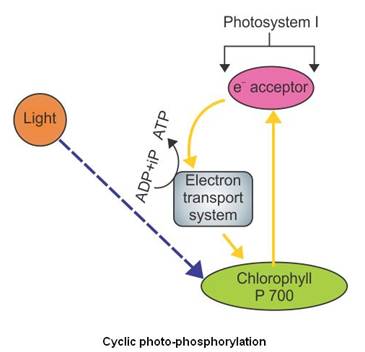
Q15. What
acts as the hydrogen donor in photosynthesis in higher plants?
Solution
In
higher plants, water is the hydrogen donor in photosynthesis.
Q16. How can a C4 plant leaf section be distinguished from that
of a C3 plant leaf section?
Solution
A section of the leaf from a C4 plant shows Kranz anatomy,
which is observed by the presence of bundle sheath cells around the vascular
bundles; this is not observed in the section of a C3 plant leaf.
Q17. Consider the following statements regarding photosynthesis:
A. ATP formation during photosynthesis
is termed photophosphorylation.
B. Kranz anatomy pertains to leaf.
C. Reduction of NADP+ to
NADPH occurs during the Calvin cycle.
D. In a chlorophyll molecule, magnesium
is present in the phytol tail
Of the above statements,
Solution
ATP and NADPH are formed during the light reaction
phase (photophosphorylation), which is used during the dark reactions for the
fixation of CO2 and the synthesis of sugars.
Kranz anatomy is a specialised anatomy of the leaves
of C4 plants where the vascular bundle is surrounded by bundle
sheath cells, which in turn are surrounded by mesophyll cells.
Q18. The correct sequence of cell organelles during photo respiration is
Solution
The first stage of photorespiration involves the formation of glycolate in the chloroplasts. Further reactions of the glycolate pathway occur in the mitochondria and peroxisomes, and eventually, a compound is formed which is returned to the chloroplasts, where the process began.
Q19. Energy required for ATP synthesis in PS II comes from
Solution
The proton gradient is formed due to accumulation of protons on the lumen side of the thylakoid. Also, the transport of electrons through the photosystem moves protons from the stroma to the lumen side, decreasing the proton concentration in the stroma and increasing it on the lumen side. This results in the generation of a proton gradient across the thylakoid membrane. The ATPase enzyme breaks down this proton gradient and uses its energy for the synthesis of ATP molecules.
Q20. Give the empirical formula for photosynthesis.
Solution

Q21. Differentiate between mesophyll and bundle sheath cells of C4
plants with respect to photosynthesis.
Solution
Mesophyll
cells
Bundle
sheath cells
Chloroplasts have grana.
Chloroplasts lack
grana.
CO2 acceptor
is phosphoenol pyruvate.
The CO2
acceptor is ribulose bisphosphate.
CO2 acceptor
molecule is present in the cytoplasm.
CO2 acceptor
molecule is present in the stroma of chloroplasts.
Q22. What is the anatomical structure of the leaves of C4 plants
known as?
Solution
Kranz anatomy
Q23. State Blackman’s law of limiting factors.
Solution
If a chemical process is affected by more
than one factor, then its rate will be determined by the factor which is
nearest to its minimal value. It is the factor which directly affects the
process if its quantity is changed.
Q24. Which law comes into effect when more than one factor affects the rate
of photosynthesis in a plant? Give one example.
Solution
Blackman’s law of limiting factors.
Example: No photosynthesis can take place
in a plant if the temperature is not optimal, even if the CO2
concentration, chlorophyll amount and light intensity are in optimal amounts.
Q25. The amount of which of the following
factors does not affect the rate of photosynthesis?
Solution
Chlorophyll
is important for photosynthesis. However, the amount of chlorophyll does not
determine the rate of photosynthesis.
Q26. What is an LHC? Where is it present?
Solution
LHC is Light Harvesting Complex. It is present in both photosystem I
and photosystem II.
Q27. What is Kranz anatomy? Describe bundle sheath cells.
Solution
When large bundle sheath cells surround the vascular bundle, the leaf
is said to have Kranz anatomy.
Bundle sheath cells are specific to C4 plants and are characterised
by having a large number of chloroplasts, thick walls impervious to gaseous
exchange and no intercellular spaces.
Q28. Who first showed that only green parts of plants could release oxygen?
Solution
Jan Ingenhousz
Q29. Which range of wavelength (in nm) is
called photosynthetically active radiation (PAR)?
Solution
400-700 nm is the range of visible light in the electromagnetic
spectrum. Plants respond to and use only visible light for photosynthesis.
680 nm and 700 nm light wavelengths are the most important for
photosynthesis.
Q30. Which of the following statements with
regard to photosynthesis is/are correct?
(a) In C4 plants, the primary
CO2 acceptor is PEP.
(b) In the photosynthetic process, PS II absorbs energy at or just
below 680 nm.
(c) The pigment which is present in PS I is P683.
Solution
P700 is the pigment which is
present in PS I and not P683.
Q31. Which of the following is formed during photorespiration?
Solution
Phosphoglycolate is a 2-carbon compound which is formed as a result of photorespiration. RuBisCO catalyses the oxygenation reaction of RuBP to form PGA and phosphoglycolate, when the concentration of O2 is high and that of CO2 is low in the cell.
Q32. Chloroplasts are externally covered by
Solution
Chloroplasts are externally covered by a double membranous structure called the chloroplast envelope. Each membrane is a unit membrane like the plasma membrane.
Q33. A reduction in the quantity of oxygen evolution during photosynthesis may be observed at
Solution
The photosynthetically active radiation (PAR) is the radiation range in which photosynthesis can occur. PAR ranges from 400 to 700 nm. Wavelengths below 360 nm do not fall under PAR, and hence, photosynthesis cannot occur, thus resulting in reduction in the quantity of oxygen evolved during photosynthesis.
Q34. Ferredoxin is a constituent of
Solution
Ferredoxin is a soluble protein which acts as an electron carrier and forms a constituent of PS I. Ferredoxin passes electrons to reductase complex which helps in reducing NADP+ to NADPH.
Q35. Consider the following statements regarding photosynthesis:
A. ATP formation during photosynthesis is termed photophorylation.
B. Kranz anatomy pertains to leaf.
C. Reduction of NADP+ to NADPH occurs during the Calvin cycle.
D. In a chlorophyll molecule, magnesium is present in the phytol tail.
Of the above statements,
Solution
Photophosphorylation is the process by which green plants use light energy for the generation of energy-rich molecules such as ATP and NADPH.
Kranz anatomy is a special type of anatomy found in the leaves of C4 plants.
Q36. The point at which the amount of CO2
fixed in photosynthesis is equal to the CO2 evolved in respiration
and photorespiration is called
Solution
When the
levels of CO2 is reduced, there comes a point in photosynthesis
that the plant stops absorbing CO2 from the atmosphere, and the
amount of CO2 fixed in the plant is equal to the amount of CO2
produced by the plant as a result of respiration and photorespiration. This
point is called the compensation point or threshold value.
Q37. Who proposed the law of limiting factor?
Solution
Blackman proposed the law of limiting factor. According to this law, ‘When a chemical process is affected by more than one factor, its rate will be determined by the factor which is nearest to its minimal value: It is the factor which directly affects the process if its quantity is changed’.
Q38. The total amount of incident light
absorbed by leaves of plants is
Solution
Of the total light incident on the
leaf, about 80% is absorbed, 10% is reflected and 10% is transmitted.
Q39. How many turns does the Calvin cycle take for the generation of one molecule of glucose?
Solution
Each turn of the Calvin cycle generates one molecule of carbon. Because a glucose molecule is a 6-carbon compound, the cycle goes about 6 times for the synthesis of one molecule of glucose.
Q40. Internally, the chloroplast consists of which fluid?
Solution
Stroma
Q41. Which hormone(s) is/are responsible for an increase in the rate of photosynthesis?
Solution
Hormones affect the rate of photosynthesis. Cytokinin and gibberellin increase the rate of photosynthesis, whereas abscisic acid reduces the rate of photosynthesis.
Q42. The light reaction of photosynthesis occurs in
Solution
The granum is the site for light reactions as it contains light-harvesting complexes, and the stroma is the site for dark reactions as it contains all the necessary enzymes required for the fixation of CO2 and the synthesis of sugars.
Q43. Flowers and fruits are brightly coloured so that they become attractive. This helps in the process of pollination. Which pigment in flowers and fruits imparts these colours?
Solution
Carotenoids are responsible for the bright colour in fruits and flowers which makes them attractive for pollination.
Q44. Oxygen
in air was discovered by
Solution
Joseph
Priestley discovered oxygen in 1774.
Q45. Which light range is most effective in photosynthesis?
Solution
Red light is more effective in photosynthesis because both the photosystems (PS I and PS II) absorb light of wavelengths in the red region (680 and 700 nm, respectively). Furthermore, blue light is absorbed by carotenoids, which pass the energy to the chlorophyll, whereas the light in the red region is absorbed by chlorophyll.
Q46. For every CO2 molecule entering the Calvin cycle, the number of ATP and NADPH required is
Solution
For every molecule of CO2 entering the Calvin cycle, 3 molecules of ATP and 2 molecules of NADPH are used. To meet the difference in the number of ATP and NADPH used in the Calvin cycle is probably why cyclic photophosphorylation takes place, as it releases only one molecule of ATP, whereas non-cyclic photophosphorylation releases one molecule of ATP and NADPH each.
Q47. In photorespiration, the cell organelles involved are
Solution
Chloroplast, mitochondrion and peroxisome are the three cell organelles which are involved in photorespiration. Their sequence of involvement is Chloroplast-peroxisome-mitochondrion.
Q48. Bacteria which live in regions such
as hot springs can perform photosynthesis even at
Solution
Bacteria which live in or near hot
springs can perform photosynthesis even at 70°C.
Q49. Blackman’s law of limiting factors
was opposed by which of the following individuals?
Solution
Boysen-Jensen, Hoover and Harder
all opposed Blackman’s law of limiting factors stating that the rate of
photosynthesis because of a limiting factor declines gradually in the form of
a curve and does not decline suddenly.
Q50. In the C4 pathway, the CO2 fixation in mesophyll cells is carried out by the enzyme
Solution
Mesophyll cells lack the enzyme RuBisCO, which carries out the Calvin cycle. PEP carboxylase is the enzyme which is found in mesophyll cells, and it catalyses the reaction of CO2 fixation by phosphoenol pyruvate.
Q51. A process which makes an important difference between C3 and C4 plants is
Solution
Photorespiration is a process which occurs due to the oxygenase activity of RuBisCO. When the concentration of O2 is high as compared to CO2, RuBisCO shows oxygenase activity. C4 plants have a mechanism by which they can maintain the high concentration of CO2 at the enzyme site; thus, photorespiration does not occur in C4 plants.
Q52. Formation of ATP in photosynthesis and respiration is an oxidation
process which uses the energy from
Solution
A high-energy electron is ejected from a molecule, which is passed
downhill through multiple electron acceptors. The energy given out by this high-energy
electron is used up for the formation of ATP during photosynthesis and
respiration.
Q53. With the help of a diagram explain the light-harvesting complex (LHC).
Solution
 LHC is a group of pigment molecules which are
associated with each other and help carry out photosynthesis.
LHC is made of hundreds of pigment molecules
except for only one chlorophyll a
molecule forming a light-harvesting system also called antennae.
The single chlorophyll a molecule forms the reaction centre, while the other
pigments serve as accessory molecules and make photosynthesis more
effective by absorbing light of different wavelengths.
LHC is a group of pigment molecules which are
associated with each other and help carry out photosynthesis.
LHC is made of hundreds of pigment molecules
except for only one chlorophyll a
molecule forming a light-harvesting system also called antennae.
The single chlorophyll a molecule forms the reaction centre, while the other
pigments serve as accessory molecules and make photosynthesis more
effective by absorbing light of different wavelengths.
Q54. Blue
and red light roughly resemble the absorption spectrum of
Solution
Blue
and red light roughly resemble the absorption spectrum of chlorophyll a and
b.
Q55. At high temperature, plants cannot
perform photosynthesis as
Solution
Most plant enzymes have their
optimum temperature at 30°C. When the temperature rises, most enzymes cannot
function and photosynthesis stops.
Q56. Which one of the following is essential for photolysis of water?
Solution
Photolysis of water requires the presence of manganese, chloride and calcium ions.
Q57. Differentiate between grana and stroma of chloroplast.
Solution
Grana
Stroma
Grana are made of stacks of
thylakoids.
Stroma is the fluid present in the
chloroplast.
Light reactions occur here.
Dark reactions occur here.
Q58. The active component of photosystem I is composed of
Solution
The chlorophyll a reaction centre for PS I has an absorption maxima
peak at 700 nm.
Q59. With the help of a diagram give a detailed description of the Calvin
cycle.
Solution
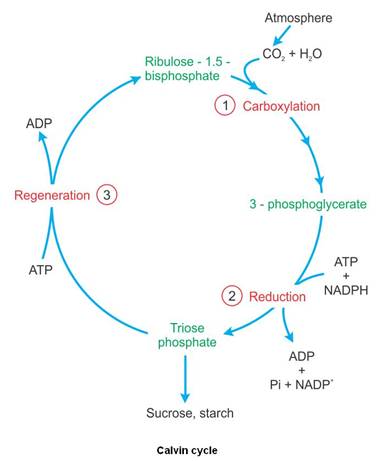 The Calvin cycle occurs in the stroma of the chloroplast.
It uses ATP and NADPH, produced during the light reactions, to synthesise
sugars by fixing CO2.
The Calvin cycle has three main stages:
Carboxylation: It is the first phase of the Calvin
cycle. It involves the carboxylation of ribulose bisphosphate by using
CO2. The reaction is catalysed by the enzyme RuBP carboxylase-oxygenase.
It results in the formation of 3-phosphoglyceric acid, the first stable
compound of the dark reactions.
Reduction: It is a series of reactions which lead
to the formation of glucose. It uses two molecules of ATP and two
molecules of NADPH for phosphorylation and reduction, respectively, per
molecule of CO2 fixed.
Regeneration: This stage involves the
regeneration of RuBP. It requires one molecule of ATP for
phosphorylation to form one molecule of RuBP.
The Calvin cycle occurs in the stroma of the chloroplast.
It uses ATP and NADPH, produced during the light reactions, to synthesise
sugars by fixing CO2.
The Calvin cycle has three main stages:
Carboxylation: It is the first phase of the Calvin
cycle. It involves the carboxylation of ribulose bisphosphate by using
CO2. The reaction is catalysed by the enzyme RuBP carboxylase-oxygenase.
It results in the formation of 3-phosphoglyceric acid, the first stable
compound of the dark reactions.
Reduction: It is a series of reactions which lead
to the formation of glucose. It uses two molecules of ATP and two
molecules of NADPH for phosphorylation and reduction, respectively, per
molecule of CO2 fixed.
Regeneration: This stage involves the
regeneration of RuBP. It requires one molecule of ATP for
phosphorylation to form one molecule of RuBP.
Q60. What is common between chloroplasts, chromoplasts and leucoplasts?
Solution
Chloroplast, chromoplast and leucoplast are plastids and have the ability to multiply by a fission-like process before they are fully mature.
Q61. In the leaves of C4 plants, malic acid formation during CO2 fixation occurs in the cells of
Solution
In C4 plants, mesophyll cells lack RuBisCO enzyme and thus cannot carry out the Calvin cycle. The primary CO2 acceptor is PEP which is converted to oxaloacetic acid (OAA). OAA is then converted to a 3-carbon compound like malic acid, which is transported to the bundle sheath cells, where it undergoes decarboxylation, and the CO2 released enters the Calvin cycle.
Q62. Select the incorrectly matched pair with regard to the C4 cycle.
Solution
The primary CO2 fixation product in C4 plants is oxaloacetic acid, which is converted to malic acid or aspartic acid that is transported to the bundle sheath cells where the acid is decarboxylated and the CO2 thus released enters the Calvin cycle.
Q63. Which pigment acts directly to convert
light energy to chemical energy?
Solution
Chlorophyll a is the reaction centre for photosynthesis and directly
converts light energy to chemical energy.
Q64. Shade-loving plants which require
low light intensity for optimum photosynthesis are called
Solution
Sciophytes are shade-loving plants
and require low light intensity for optimum photosynthesis.
Q65. Which one of the following statements about the events of non-cyclic
photophosphorylation is incorrect?
Solution
In non-cyclic photophosphorylation, both PS I and PS II participate.
Q66. 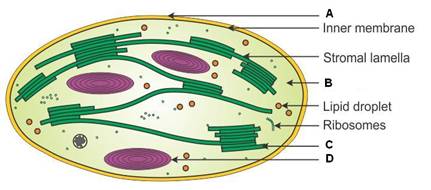 Which is the correct labelling for A, B,
C and D?
Which is the correct labelling for A, B,
C and D?
 Which is the correct labelling for A, B,
C and D?
Which is the correct labelling for A, B,
C and D?Solution
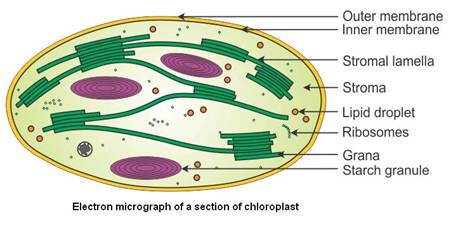
Q67. RuBisCO is the most abundant enzyme in the world and present in very high concentration in chloroplasts. It is required in very high concentration for
photosynthesis because it
Solution
RuBisCO is a very slow-acting enzyme as it can capture only a few molecules of CO2 for fixation; thus, it is produced in large amounts in plants to carry out optimum levels of photosynthesis.
Q68. Which metal ion is a constituent of
chlorophyll?
Solution
Magnesium is an important component of
chlorophyll. It is held within the tetrapyrrole ring by two covalent and two coordinate
bonds. Magnesium in chlorophyll helps in absorption of light energy and
excitation of electrons.
Q69. Internally, the chloroplast is divided into two parts - the membrane system and the fluid portion called stroma. Labour is equally divided between the two parts with each responsible for a particular function of photosynthesis leading to the formation of sugars. Which part(s) is/are involved in the synthesis of ATP and NADPH?
Solution
The membrane system of the chloroplast is responsible for the trapping of light energy and synthesis of ATP and NADPH. The stroma carries out enzymatic reactions which incorporate CO2 in plants leading to the synthesis of sugars which later forms starch.
Q70. Energy released during the movement of electrons through the photosystems in photosynthesis is used to drive protons across the membrane against the concentration gradient. As a result, the protons accumulate in
Solution
Splitting of water and transport of electrons through the series of electron acceptors result in the pumping of protons in the thylakoid lumen which results in the generation of a proton gradient across the thylakoid lumen.
Q71. Non-cyclic photophosphorylation results in the production of
Solution
Non-cyclic photophosphorylation results in the production of ATP, NADPH and O2. O2 thus produced is released in the atmosphere while ATP and NADPH are used during the dark reaction for the synthesis of sugars.
Q72. Which of the following is correctly labelled for the given figure?
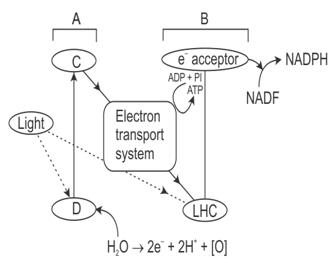

Solution
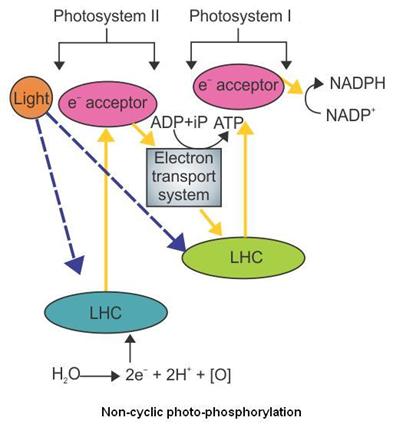
Q73. Which of the following statements regarding the C4 pathway is false?
Solution
The bundle sheath cells do not contain the enzyme PEPCase. Instead, the bundle sheath cells contain the enzyme RuBisCO; thus, the Calvin cycle occurs in them by CO2 released due to the decarboxylation of malic acid or aspartic acid.
Q74. Who showed that oxygen evolved during photosynthesis comes from water
and not carbon dioxide? How did he/she infer that?
Solution
Cornelius van
Niel showed that oxygen evolved in photosynthesis is from water and not
carbon dioxide.
He conducted
experiments on purple and green sulphur bacteria, in which H2S is
the hydrogen donor and not H2O. In the presence of H2S,
sulphur or sulphate is released as the oxidation product depending on the
organism.
Whereas in green plants, H2O is
used as a hydrogen donor and oxygen is given out as an oxidation product.
Hence, van Niel inferred that oxygen is released from water and not carbon
dioxide.
Q75. The graph for the rate of photosynthesis versus light intensity is
given. Based on it, answer the following questions:
At which point in the graph is light a limiting
factor for photosynthesis?
What is/are the limiting factor(s) at point A?
What do points C and D represent on the graph?


Solution
A
Temperature, CO2 concentration,
light
C represents the steady rate of photosynthesis
and that some other factor is limiting. D
is the optimum light intensity and that at point D the rate of
photosynthesis is maximum.
Q76. Stomata of CAM plants
Solution
The CAM cycle is an adaptation in
succulent plants. In plants with the CAM cycle, the stomata remain close
during the day and open during the night. This helps in preventing loss of
water due to transpiration.
Q77. Which chlorophyll molecule does not have a phytol tail?
Solution
Chlorophyll c is an accessory pigment and forms part of the antennae system. It is different from the rest of the chlorophyll molecules as it lacks a phytol tail. It is generally found in some marine algae (e.g. diatoms).
Q78. Which one of the following concerns photophosphorylation?
Solution
In photophosphorylation, electrons are passed along a series of electron acceptors. The energy given out by the electrons is used for the synthesis of energy-rich molecules such as ATP and NADPH. ATP is synthesised from ADP and inorganic phosphate.
Q79. Why are leaves of a plant present on the shaded side more dark green
as compared to those present on the sunny side?
Solution
Leaves on the shaded side are more green as compared to those present
on the sunny side because they have more chlorophyll.
Chlorophyll is responsible for the green colour of leaves. Because the
leaves are on the shaded side, they need more chlorophyll to trap more light
to carry out photosynthesis.
Q80. The Calvin cycle is
Solution
The Calvin
cycle is a reductive carboxylation process as it involves the carboxylation
of RuBP to 3-PGA and the further reduction of 3-PGA by a series of steps which
leads to the synthesis of sugars.
Q81. Electrons from an excited chlorophyll molecule of photosystem II are accepted first by
Solution
Quinine is the first electron acceptor for electrons given out by photosystem II.
Q82. The creation of proton gradient across the thylakoid membrane is a result of
Solution
The proton gradient is generated due to the accumulation of protons on the inner side of the lumen and a decrease in pH on the lumen side of the thylakoid membrane.
Q83. Give the equation for photolysis of water and give the fate of each of
the products so formed.
Solution
2H2O ————› 4H+ + O2
+ 4e−
The products so formed are
H+/protons - These are used for the reduction
of NADP to NADPH.
Oxygen - It is liberated in the air and replenishes
oxygen in the environment.
Electrons - These are used to replace electrons
lost by PS II.
Q84. The first stable compound in C3
plants is
Solution
3-Phosphoglycerate
is the first stable compound which is formed in the C3 cycle in
the carboxylation stage. The reaction uses CO2 and RuBP, a five-carbon
compound, with the reaction being catalysed by RuBP carboxylase.
Q85. Kranz anatomy is one of the characteristics of the leaves of
Solution
Kranz anatomy is a special type of leaf anatomy seen in C4 plants. In these plants, the vascular bundles are surrounded by concentric rings of bundle sheath cells which in turn are surrounded by mesophyll cells. Sugarcane being a C4 plant shows Kranz anatomy in its leaves.
Q86. The number of thylakoids in a granum is
Solution
The number of thylakoids in a granum can vary from 2 to 100.
Q87. Thylakoids occur inside
Solution
Thylakoids are disc-shaped structures present in the chloroplast. They
stack up to form the grana. Thylakoids are the sites for oxygenic
photosynthesis in eukaryotic plants and algae.
Q88. Consider a plant which lacks chlorophyll a but has chlorophyll b;
will it carry out photosynthesis? What is the role of chlorophyll b and other accessory pigments?
Solution
No. The plant cannot carry out photosynthesis without chlorophyll a because it is the reaction centre
for photosynthesis.
Chlorophyll b and other
accessory pigments absorb light at other wavelengths and pass it to the
reaction centre for efficient photosynthesis.
Q89. Which one of the following occurs in both cyclic and non-cyclic
photophosphorylation?
Solution
In cyclic photophosphorylation, only a molecule of ATP is released,
while in non-cyclic photophorylation, both ATP and NADPH are released.
Q90. Chlorophyll in chloroplasts is located in
Solution
Grana are structures present in the chloroplast made of stacks of
flattened discs called thylakoids. Thylakoids contain the photosystems within
which photosynthetic pigments are present.
Q91. Bulk fixation of carbon through photosynthesis takes place in
Solution
Oceans cover a large portion of the earth. The ocean is home to a large amount of organisms which include both producers and consumers. In oceans, microscopic organisms (e.g. cyanobacteria and dinoflagellates) along with multicellular producers (e.g. sea weed and sea grass) account for most of the CO2 fixation on Earth.
Q92. Light saturation point for shade plants is at how much percent of full sunlight?
Solution
The light intensity at which a plant reaches the maximum photosynthesis rate is known as the light saturation point. This is about 10% of full sunlight for shade plants, 50-70% of full sunlight for C3 sun plants and up to 200% for C4 sunplants.
Q93. During the Calvin cycle, the total number of CO2, ATP and NADPH molecules utilised and glucose, ADP and NADP molecules generated is
Solution
The total number of ATP, NADPH and CO2 utilised and ADP, NADP and glucose generated is 67.
6CO2 + 18ATP + 12 NADPH + 12H2O ———> C6H12O6 + 18ADP + 18 Pi + 12NADP+ + 6H+
Q94. What are pigments? Name the types of pigments found in the leaf of a
green plant?
Solution
Pigments are substances which can absorb light.
The four major pigments found in the leaves of green plants are
Chlorophyll a
Chlorophyll b
Xanthophylls
Carotenoids
Q95. Which of the following statements is true with regard to the light
reaction of the photosynthetic mechanism in plants?
Solution
In non-cyclic photophosphorylation, the electrons are passed from PS
II to PS I, and PS II gains its lost electron from the splitting of water.
Because the same electron does not return to PS II, it is called non-cyclic
photophosphorylation.
Q96. In the C3, cycle for the fixation of every CO2 molecule, the reduction and regeneration steps require
Solution
For every molecule of CO2 entering the Calvin cycle, 3 molecules of ATP and 2 molecules of NADPH are used. Probably to meet the difference in the number of ATP and NADPH used in the Calvin cycle is why cyclic photophosphorylation occurs, as it releases only one molecule of ATP, whereas non-cyclic photophosphorylation releases one molecule of ATP and NADPH each.
Q97. In the half-leaf experiment of photosynthesis, KOH solution is used because
Solution
KOH is a strong alkali and CO2 is an acidic oxide; thus, the two react in an acid base reaction which results in the absorption of CO2 from the air.
KOH + CO2 ———> KHCO3 + K2CO3 +H2O
Q98. What do ATP and NADPH stand for?
Solution
ATP - Adenosine triphosphate
NADPH - Nicotinamide adenine dinucleotide phosphate
Q99. At which phase of the dark reaction is glucose formed?
Solution
Glucose is formed during the reduction phase of the Calvin cycle.
Q100. The
first action spectrum of photosynthesis was described by
Solution
The
first action spectrum of photosynthesis was described by T. W. Engelmann.
Q101. ATP can be formed in the photosynthesising plant cells by
Solution
Photosynthesising plant cells produce ATP by the process of
photophosphorylation by using light energy, ADP and inorganic phosphate.
Q102. The type of CO2 fixation seen in many succulent plant species is
Solution
Succulent plants are those that live in arid climates or regions with water scarcity. To preserve water in them, they have adapted to the CAM pathway where their stomata remain closed during the day and open at night to prevent the loss of water due to transpiration.
Q103. Name a technique used for the separation of photosynthetic pigments.
Which pigments are separated? How do you distinguish pigments from each
other?
Solution
Chromatography is used for the separation of photosynthetic pigments.
The pigments separated by this technique are
Chlorophyll a
Chlorophyll b
Xanthophylls
Carotenoids
Each of the separated pigments appears with a different colour and
thus can be easily differentiated.
Chlorophyll a
- Bright or blue green
Chlorophyll b
- Yellow green
Xanthophylls - Yellow
Carotenoids - Yellow to yellow orange
Q104. For the production of one molecule of glucose by Calvin cycle, how
many molecules of CO2 need to be fixed?
Solution
Six molecules of CO2 are fixed for the production of one
molecule of glucose by the Calvin cycle.
Q105. Which one does not occur in cyclic photophosphorylation?
Solution
NADPH formation does not take place in cyclic photophosphorylation. In
this pathway, only a single molecule of ATP is synthesised.
Q106. C55H72O5N4Mg is the chemical formula for which photosynthetic pigment?
Solution
The chemical formula of chlorophyll a is C55H72O5N4Mg, while that of chlorophyll b is C55H70O6N4Mg.
Q107. Melvin Calvin was professor of
Solution
Melvin Calvin was a professor of chemistry who along with Benson and Bassham determined the series of reactions which constitutes the C3 cycle or Calvin cycle using radioactive carbon 14C.
Q108. Chloroplast dimorphism is a
characteristic feature of
Solution
C4 plants are different from
C3 and CAM plants in the sense that they possess two types of
chloroplasts, found in two different cell types. The chloroplasts found in
mesophyll cells possess grana, while those found in bundle sheath cells are
agranal.
Q109. T.
W. Engelmann used which organism in his experiments for determining the role
of red and blue light in photosynthesis?
Solution
T.
W. Engelmann used the green alga Cladophora
in his experiments for determining the role of red and blue light in
photosynthesis.
Q110. The correct sequence of flow of electrons in the light reaction is
Solution
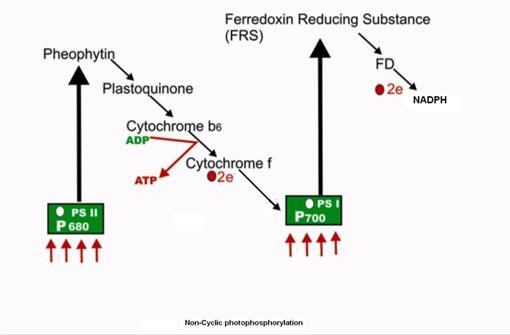
Q111. Why does the Calvin cycle not occur in mesophyll cells?
Solution
Mesophyll cells lack the enzyme RuBisCO and thus cannot carry out the Calvin
cycle.
Q112. The Calvin cycle leads to reduction of
Solution
CO2 in
the Calvin cycle is used for the carboxylation of RuBP in the carboxylation
phase; this results in the formation of two 3-PGA which is further reduced in
the cycle for the formation of sugars.
Q113. Who described the first action spectrum for photosynthesis?
Solution
T. W. Engelmann described the first action spectrum of photosynthesis in his experiments with Cladophora and aerobic bacteria illuminated with independent spectral components of light which are split using a prism.
Q114. Cornelius
van Niel demonstrated
that photosynthesis is essentially a light-dependent reaction. He based his
study on which organism?
Solution
Cornelius
van Niel based his study on purple and green bacteria and demonstrated that
photosynthesis is essentially a light-dependent reaction.
Q115. The movement of electrons from chlorophyll molecule to NADP occurs in
Solution
In non-cyclic photophosphorylation, electrons are passed on from PS II
to PS I and then finally to NADP, through a series of electron acceptors, for
the synthesis of NADPH.
Q116. The Calvin cycle occurs in plants following which pathway?
Solution
The Calvin cycle occurs in all photosynthetic plants irrespective of
whether they have the C3 or C4 pathway.
Q117. Why is that leaves kept in dark frequently become yellow or pale green
in colour? Which chloroplast pigment is more stable?
Solution
In the dark, there is no production of
chlorophyll.
Chlorophyll present in the leaf is degraded,
thus making the leaf pale green or yellow.
Carotenoid is a more stable pigment.
Q118. Which elements are essential for photophosphorylation?
Solution
Mn and Cl are useful for light reactions as they are important for the process of splitting of water.
Q119. How are molecules of the C4 cycle exchanged between the
mesophyll and bundle sheath cells?
Solution
The molecules of the C4 pathway are exchanged through the
plasmodesmata, which are pore-like channels that connect the mesophyll and
bundle sheath cells.
Q120. In coniferous plants,
photosynthesis can take place at a temperature as low as
Solution
In coniferous plants,
photosynthesis can even take place at −35°C.
Q121. Light reactions include which all processes?
Solution
Light reactions include:
Absorption of light
Splitting of water molecule
Release of oxygen
Formation of high-energy chemical
intermediates, ATP and NADPH
Q122. With the help of a diagram explain the experiment conducted by Joseph
Priestley. Give its conclusions.
Solution
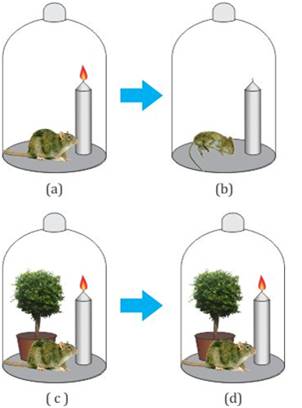 Joseph Priestley conducted an experiment to
determine the importance of air for the growth of green plants.
He conducted a series of experiments in which
he placed a burning candle and a mouse in a bell jar, such that no air
could leave or enter the jar.
He observed that in this set, the mouse died of
suffocation.
In the next set, he placed a mint plant along
with the mouse and burning candle in the jar. Here, the mouse did not
suffocate and lived, and the candle kept on burning.
Based on these sets of the experiment,
Priestley concluded that
Animals which breathe air or a burning candle
damaged the air in some way.
Green plants restore to the air whatever the burning
candle or breathing animals remove.
Joseph Priestley conducted an experiment to
determine the importance of air for the growth of green plants.
He conducted a series of experiments in which
he placed a burning candle and a mouse in a bell jar, such that no air
could leave or enter the jar.
He observed that in this set, the mouse died of
suffocation.
In the next set, he placed a mint plant along
with the mouse and burning candle in the jar. Here, the mouse did not
suffocate and lived, and the candle kept on burning.
Based on these sets of the experiment,
Priestley concluded that
Animals which breathe air or a burning candle
damaged the air in some way.
Green plants restore to the air whatever the burning
candle or breathing animals remove.
Q123. The hydrogen donor for purple and green sulphur bacteria is
Solution
H2S serves as a hydrogen donor in purple and green sulphur bacteria. The oxidation product thus released is either sulphur or sulphate instead of oxygen.
Q124. Define photolysis of water.
Solution
It is the process by which water is split into H+, oxygen
and electrons in the presence of light by photosystem II.
Q125. In the overall process of photosynthesis, the number of CO2, water, sugar and 02 molecules utilised and produced is
Solution
6CO2 + 12H2O  C6H12O6 + 6O2 + 6H2O (Total molecules involved are 31.)
C6H12O6 + 6O2 + 6H2O (Total molecules involved are 31.)
Q126. Why is the lumen of the thylakoids more acidic in nature?
Solution
The splitting of water releases H+ ions/protons which accumulate
in the lumen of the thylakoids, making it more acidic in nature.
Q127. In Priestley’s experiment for
photosynthesis, the mouse died in the setup which did not contain the mint
plant because of
Solution
The mouse and burning candle both use up
oxygen from the air in the jar for respiration and combustion, respectively;
thus, the mouse dies due to suffocation as no more oxygen is available.
Q128. Which pigments constitute the accessory pigments in the thylakoid?
Solution
Accessory pigments include
Chlorophyll b
Xanthophylls
Carotenoids
Q129. Why is chlorophyll a the
chief photosynthetic pigment?
Solution
Chloroplast a is the chief
photosynthetic pigment as it shows higher rates of photosynthesis.
Q130. The membrane system of chloroplast is responsible for the synthesis of
which two molecules?
Solution
ATP and NADPH
Q131. When does Blackman’s law of limiting factors come into effect?
Solution
When there are several or more than one factor which affect any
biochemical or chemical process.
Q132. In PS-II, the first known electron acceptor is
Solution
Pheophytin is the primary electron acceptor for PS II. It picks up the electron given out by P680 and passes it to the next electron acceptor plastoquinone, which further passes it to the cytochrome complex.
Q133. The chemiosmotic theory for photophosphorylation was given by
Solution
Chemiosmotic theory was proposed by P. Mitchell in 1961; the theory suggested that most of the ATP synthesis which occurs in respiring cells comes from an electrochemical gradient formed across the mitochondrial or chloroplast membrane.
Q134. Consider the following statements:
(a) The portion of the spectrum between
500 nm and 800 nm is also referred to as photosynthetically active radiation
(PAR).
(b) Magnesium, calcium and chloride ions
play prominent roles in the photolysis of water.
(c) In cyclic photophosphorylation,
oxygen is not released (as there is no photolysis of water) and NADPH is also
not produced.
Of these statements given above,
Solution
During cyclic photophosphorylation, only a single molecule of ATP is synthesised
and there is no photolysis of water, no release of O2 and no
synthesis of NADPH.
Q135. The scientist awarded the Noble Prize in 1960 for tracing the path of carbon in plants is
Solution
Melvin Calvin was awarded the Nobel Prize in 1960 for tracing the path of carbon in plants. This pathway is known as the Calvin cycle or C3 cycle. He used the radioisotope of carbon 14C for tracing the path of carbon in algal photosynthesis.
Q136. Which part of the ATPase enzyme forms a transmembrane channel in the thylakoid membrane which carries out facilitated diffusion of protons across the membrane?
Solution
The ATPase enzyme consists of two parts - F0 and F1. F0 is embedded in the thylakoid membrane and forms a transmembrane channel which carries out facilitated diffusion of protons across the membrane. F1 protrudes to the outer side of the membrane to face the stroma and carries out synthesis of ATP molecules.
Q137. Who demonstrated the importance of sunlight for the process of photosynthesis?
Solution
Jan Ingenhousz conducted the experiment with the same setup as that used by Joseph Priestley to determine the importance of air for photosynthesis; however, instead of placing the setup in light, he placed it in dark. He observed that the plant could not help keep the candle burning.
Q138. State the effect of CO2 concentration on C3 and
C4 plants under the following conditions:
Low light and high CO2 concentration
High light intensities
Saturation CO2 concentration
Solution
Both
C3 and C4 plants do not respond to low light and
high CO2 concentration.
Both
C3 and C4 plants respond to high light and high CO2
concentration by an increase in the rate of photosynthesis.
Saturation
concentration of CO2 for
C3
plants: Above 450 μlL−1
C4
plants: At 360 μlL−1
Q139. The primary CO2 acceptor in C3
plants is
Solution
RuBP, a 5-carbon
compound, is the primary CO2 acceptor in C3 plants.
RuBP with the help of CO2 undergoes carboxylation to form two
molecules of 3- phosphoglycerate, a 3-carbon compound.
Q140. Describe Jan Ingenhousz experiment to determine the importance of
sunlight for photosynthesis.
Solution
Jan Ingenhousz used an aquatic plant for his experiment. He observed
that small bubbles were released in the presence of sunlight, while no
bubbles were released in the dark.
These bubbles when tested were of oxygen, which was released during
photosynthesis. Thus, his experiment suggested that sunlight was important
for photosynthesis.
Q141. Draw a neat and labelled diagram of chloroplast. What are accessory
pigments? State their functions.
Solution
 Accessory pigments are pigments other than chlorophyll a which help in the absorption of
light.
They help perform the following functions:
Widen the range of light absorbed in the
chloroplast.
Absorb light and transfer the energy to
chlorophyll a, which is the
reaction centre for photosynthesis.
Protect chlorophyll a from photo-oxidation.
Accessory pigments are pigments other than chlorophyll a which help in the absorption of
light.
They help perform the following functions:
Widen the range of light absorbed in the
chloroplast.
Absorb light and transfer the energy to
chlorophyll a, which is the
reaction centre for photosynthesis.
Protect chlorophyll a from photo-oxidation.
Q142. The compensation point of CO2 for C3 plants is
Solution
The compensation point for CO2 is the point where the plant does not absorb any CO2 from the surrounding as the levels of CO2 used in photosynthesis is equal to the amount of CO2 released by respiration and photorespiration. In C3 plants, this value of the compensation point for CO2 is 25-100 ppm.
Q143. A photosystem is composed of
Solution
A photosystem is composed of both a reaction centre as well as a light-harvesting
complex which are involved in trapping light and synthesising energy-rich
molecules like ATP and NADPH.
Q144. Which is the first acceptor molecule in the Calvin cycle?
Solution
Ribulose bisphosphate (RuBP), a five-carbon ketose sugar
Q145. Give a diagrammatic representation of the Calvin cycle.
Solution

Q146. Draw a standard graph for light intensity versus the rate of
photosynthesis.
Solution

Q147. Define photosynthesis.
Solution
Photosynthesis is a physicochemical process by which green plants and
certain other organisms use light energy for synthesising organic compounds.
Q148. Which of the following statements is true with regard to the light
reaction of photosynthesis?
Solution
The Z scheme of photophosphorylation involves both PS I and PS II with
the electrons moving from PS II to PS I and from water to PS II.
Q149. Which technique is used to separate leaf pigments?
Solution
Paper chromatography
Q150. Differentiate between PS I and PS II.
Solution
Photosystem
I
Photosystem
II
It has absorption maxima at 700 nm.
It has absorption maxima at 680 nm.
It operates in both cyclic and non-cyclic photophosphorylation.
It operates only in non-cyclic
photophosphorylation.
Q151. Which of the following is an inhibitor of non-cyclic photophosphorylation?
Solution
DCMU, CMU and diquat are herbicides and inhibit plant growth by blocking non-cyclic photophosphorylation.
Q152. What is the first stable compound formed from CO2 fixation
in C4 plants?
Solution
Oxaloacetic acid
Q153. Jan
Ingenhousz determined the importance of which factor for photosynthesis?
Solution
Jan
Ingenhousz modified Joseph Priestley’s experiment and demonstrated that
sunlight is important for the process of photosynthesis.
Q154. Aquatic
plants giving out oxygen in the gaseous form was demonstrated by
Solution
Jan
Ingenhousz kept aquatic green plants in sunlight and found bubbles coming out
of the plant. These bubbles were not formed in the dark. On further testing,
he found that these bubbles were oxygen.
Q155. In which photophosphorylation process both ATP and NADPH are produced
and in which only ATP is produced?
Solution
In non-cyclic photophosphorylation, both ATP and NADPH are produced. In
cyclic photophosphorylation, only ATP is produced.
Q156. What did Priestley hypothesise following his experiment with a plant,
mouse and burning candle inside a bell jar?
Solution
Plants restore to the air whatever breathing animals and burning
candles remove.
Q157. A photosynthesising plant is releasing 18O more than the normal amounts; thus, the plant must be supplied with
Solution
Ruben, Hassid and Kamen, using an isotope of oxygen (18O) in water, found that oxygen evolved during photosynthesis comes from water.
Q158. Which one of the following is wrong in
relation to photorespiration?
Solution
RuBisCO has both carboxylase and
oxygenase activity. When the concentration of CO2 is high, it
shows carboxylase activity leading to the Calvin cycle, and when the
concentration of O2 is high, it shows oxygenase activity leading
to photorespiration. Photorespiration does not occur in C4 plants;
this is because they have a mechanism for increasing the concentration of CO2
at the site of the RuBisCO enzyme.
Q159. Photosynthetically active radiation (PAR) represents which of the following range of wavelength?
Solution
400-700 nm wavelength of the electromagnetic spectrum belongs to the visible light region which is the main and only source of light for photosynthesis.
Q160. What is the first stable compound formed in the Calvin cycle?
Solution
3-Phosphoglyceric acid
Q161. The enzyme which is not found in a C3
plant is
Solution
PEP carboxylase
is an enzyme found in mesophyll cells of C4 plants. It is
responsible for the fixation of phosphoenol pyruvate (PEP) and CO2.
PEP is the primary CO2 acceptor which is found only is C4
plants and not in C3 plants; thus, PEP carboxylase is absent in C3
plants.
Q162. Factors affecting the rate of photosynthesis are grouped under which
two categories?
Solution
External factors and internal factors
Q163. In higher plants, the shape of the chloroplast is
Solution
Discoid-shaped chloroplast is found in higher plants, whereas
cup-shaped chloroplast is found in the green algae Chlamydomonas. Ulothrix
has girdle-shaped chloroplasts and Chlorophyceae have reticulate
chloroplasts.
Q164. Read the following four statements (A-D).
(A) Both photophosphorylation and oxidative phosphorylation involve the
uphill transport of protons across the membrane.
(B) In dicot stems, a new cambium originates from the cells of the pericycle
at the time of secondary growth.
(C) Stamens in Dowers of Gloriosa and Petunia are polyandrous.
(D) Symbiotic nitrogen fixers occur in free-living state also in soil.
How many of the above statements are right?
Solution
Statements B and D are true, while A and C are false.
Q165. The splitting of water occurs in which part of the chloroplast? What
is its significance?
Solution
Splitting of water takes place near PS II, located in the inner side
of the thylakoid membrane.
Splitting of water releases oxygen in the atmosphere and generates a
proton gradient across the thylakoid membrane.
Q166. Why do chloroplasts align themselves along the walls of mesophyll
cells?
Solution
Chloroplasts align themselves along the walls of mesophyll cells to obtain
optimum quantity of the incident light.
Q167. Name the site for the following in C4 plants:
PEP regeneration
Calvin cycle
Solution
Mesophyll cells
Bundle sheath cells
Q168. List the internal and external factors which affect the rate of
photosynthesis, and give details on three external factors.
Solution
Factors affecting the rate of photosynthesis
are classified under two categories:
Internal factors: Leaf size, number of leaves,
shape of leaves, amount of chloroplast, mesophyll cell content,
chlorophyll and internal concentration of CO2
External factors: CO2 concentration,
sunlight, temperature and availability of water
External factors which affect the rate of
photosynthesis:
Light:
At low light intensities, there is a linear
relationship between incident light and CO2 fixation rates.
At high light intensities, the rate of
photosynthesis does not increase but other factors become limiting.
Light saturation occurs at 10% of full
sunlight.
Light is usually not a limiting factor, but
when light intensity increases beyond a point, it causes break down of
chlorophyll and decrease in photosynthesis.
Temperature:
Temperature mainly affects the dark reaction of
photosynthesis.
C4 plants respond to higher
temperatures and show higher rates of photosynthesis.
C3 plants, on the other hand, have a
much lower temperature optimum.
The temperature dependency of plants for the rate
of photosynthesis also depends on the habitat which the plant is living
and the group of plants to which it belongs.
Water:
Water affects the rate of photosynthesis
indirectly.
Water stress causes the stomata to close in
order to reduce transpiration. Closed stomata lead to decrease
concentration of CO2 in the cells, thus resulting in decrease
in photosynthesis.
Water stress also causes the leaves to wilt,
thus reducing the surface area for photosynthesis.
Q169. How does water affect the rate of photosynthesis?
Solution
Water affects the rate of photosynthesis
indirectly. Water stress causes the stomata to close, thus reducing the
availability of CO2. It also causes the leaves to wilt, reducing
the surface area for photosynthesis.
Q170. Give a diagrammatic representation of cyclic and non-cyclic
photophosphorylation.
Solution

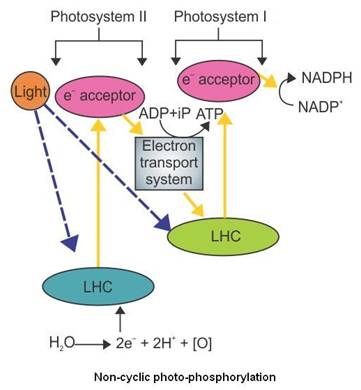
Q171. Describe the half-leaf experiment on photosynthesis.
Solution
A potted plant is kept in the dark for 48-72
hours for destarching.
A part of a leaf is enclosed in a test tube
containing some KOH solution, and the other half is kept out exposed to
air.
It is made sure that the leaf does not break
off from the plant body while the experiment is going on.
The setup is then kept in sunlight for some
time.
Later, the leaf is tested for the presence of
starch.
The starch test shows that the exposed part of
the leaf tests positive for starch, while the part in the test tube
tests negative for starch.
This shows that carbon dioxide is necessary for
photosynthesis.
Q172. How is the yield of greenhouse crops such as tomato and bell pepper
increased through photosynthesis?
Solution
The yield in greenhouse crops of tomato and
bell pepper is increased by growing them in a carbon dioxide-rich
environment.
Q173. Which cyclic process is involved in dark reactions? Give the balanced
equation for the same.
Solution
Calvin cycle:
6CO2 + 18ATP + 12NADPH ———› Glucose
+ 18ADP + 12 NADP + 18Pi
Q174. Define biosynthetic phase.
Solution
The process by which ATP and NADPH produced during the light reactions
of photosynthesis are used to synthesise sugars is called the biosynthetic
phase.
Q175. What do you observe when you plot a graph for light intensity versus the
rate of photosynthesis?
Solution
A linear graph with a plateau is observed
where the rate of photosynthesis increases up to a certain point. If light
intensity is increased further, then the rate of photosynthesis does not
increase but remains constant.
Q176. Which is the primary CO2 acceptor in C4 plants?
Solution
The primary CO2 acceptor in C4 plants is the 3-carbon
molecule phosphoenol pyruvate (PEP).
Q177. Give a detailed account of the Hatch and Slack pathway with the help
of a diagram.
Solution
The Hatch and Slack pathway is a cyclic pathway
for CO2 fixation.
The primary CO2 acceptor is a
3-carbon compound phosphoenol pyruvate (PEP) which is present in
mesophyll cells.
PEP in the mesophyll cells is converted to
oxaloacetic acid (OAA), which is then further converted into a 4-carbon
compound such as malic acid or aspartic acid, which is then transported
to the bundle sheath cells.
In the bundle sheath cells, it is again broken
down into a 3-carbon compound with the release of CO2.
The CO2 released enters the Calvin
cycle in the bundle sheath cells, while the 3-carbon compound is
transported back to the mesophyll cells.
In the mesophyll cells, the 3-carbon compound
is converted back to PEP, thus completing the cycle.
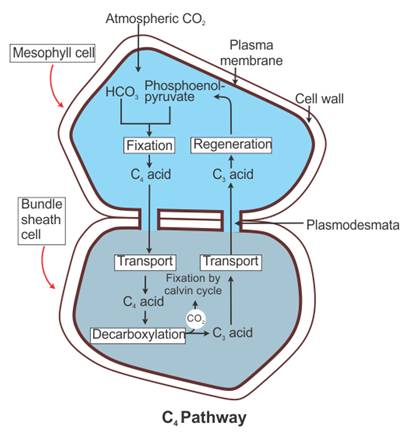

Q178. How does an increase in light intensity affect the rate of
photosynthesis?
Solution
When there is an increase in the incident light beyond a point, it
causes the breakdown of chlorophyll, thus decreasing photosynthesis.
Q179. What is the biosynthetic phase also known as? Why is it called so?
What products does it require and what is the end-product of the process?
Solution
The biosynthetic phase is also called the dark reaction.
It is called so because it does not require the presence of light for
its commencement; that is, it is light-independent.
The products necessary for the biosynthetic phase are ATP and NADPH,
which are obtained from the light reactions. The final product of the biosynthetic
phase is sugar (glucose).
Q180. In which region of the visible light spectrum does most photosynthesis
take place?
Solution
Most photosynthesis corresponds to the blue and red regions of the
visible spectrum.
Q181. Describe the experiment performed by T. W. Engelmann to determine the
first action spectrum of photosynthesis.
Solution
Engelmann used a prism to split light into its spectral components,
and then illuminated a green alga, Cladophora, placed in a suspension
of aerobic bacteria. The bacteria were used to detect the sites of oxygen
evolution.
He observed that bacteria mainly accumulated in the region of blue and
red light of the split spectrum, thus giving the first action spectrum of
photosynthesis.
Q182. How is oxygen produced during photosynthesis?
Solution
During non-cyclic photophosphorylation, PS I passes its electron to
NADP+ for the production of NADPH + H+. This lost
electron of PS I is obtained from PS II, which in turn obtains its electron from
the splitting of water. When the water molecule is split to provide an
electron to PS II, it produces protons as well as oxygen which is released
out as a molecule of oxygen.
Q183. How did Melvin Calvin find the first stable compound formed in the
biosynthetic phase?
Solution
Calvin used 14C, a radioactive isotope of carbon, in CO2
which he supplied to the green photosynthetic algae which he used for his
studies. The algae used up the CO2 for fixation in photosynthesis.
He observed that the first compound formed after some time with the presence
of the radioactive 14C was 3-phosphoglycerate, suggesting it as
the first stable compound of CO2 fixation.
Q184. Which enzyme catalyses the carboxylation of ribulose bisphosphate using
CO2?
Solution
Ribulose bisphosphate carboxylase-oxygenase (RuBisCO)
Q185. Give a diagrammatic representation for the C4 pathway.
Solution
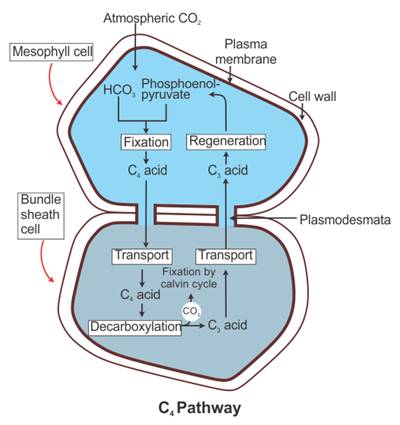
Q186. Why is photorespiration called a wasteful process?
Solution
In photorespiration, there is no synthesis of ATP or NADPH; thus, it
is called a wasteful pathway.
Q187.  Which pigments correspond to a, b and c shown in the graph?
Which pigments correspond to a, b and c shown in the graph?
 Which pigments correspond to a, b and c shown in the graph?
Which pigments correspond to a, b and c shown in the graph? Solution
The pigments corresponding to the labels are
Chlorophyll b
Carotenoids
Chlorophyll a
Q188. Quantasomes were discovered by
Solution
Quantasomes were identified by Park in 1962 and then by Biggins in 1964.
Q189. Differentiate between C3 and C4 plants on the
basis of anatomy.
Solution
C3
plants
C4
plants
Kranz anatomy is absent
in leaves.
Leaf shows the presence
of Kranz anatomy, with bundle sheath cells arranged around the vascular
bundle.
Chloroplasts are of a
single type with the presence of grana.
Chloroplast is
dimorphic. Chloroplasts of mesophyll cells have grana and those of bundle
sheath cells do not.
Q190. Which is the first stage of Calvin cycle? Give details about it.
Solution
The first stage of the Calvin cycle is carboxylation.
It involves the fixation of CO2 into a stable organic
intermediate. CO2 is used for the carboxylation of ribulose
bisphosphate, a five-carbon ketose sugar, to form two molecules of 3-PGA.
This reaction is catalysed by the enzyme ribulose bisphosphate carboxylase-oxygenase.
Q191. What happens to the electron which is passed on through the cyclic
photophosphorylation process?
Solution
The electron is released from PS I and, after moving through a series
electron acceptors, it goes back to PS I.
Q192.
Give details for the following experiments:
Importance of sunlight for photosynthesis
Hydrogen for photosynthesis
Give the overall equation for photosynthesis.
Solution
Details for the experiments :
a. Jan Ingenhousz showed that sunlight is important for the process of photosynthesis. In his experiment, he used aquatic plants. He observed that the plant produced small bubbles around its green parts in the presence of sunlight; whereas, the plant did not produce any bubbles in the dark. Later, he found that these bubbles were of oxygen. Because photosynthesis is the only process by which plants produce oxygen, he could conclude that plants produce oxygen only in the presence of sunlight and thus photosynthesis only occurs when sunlight is present.
b. Cornelius van Niel showed that hydrogen is important for photosynthesis as it is used to reduce carbon dioxide to carbohydrates. Green plants use water as a hydrogen donor which is oxidised to O2. He based his experiments on purple and green sulphur bacteria which used H2S as a hydrogen donor, and the oxidation product so formed in them is sulphur or sulphate depending on the organism. Thus, based on these observations, he inferred that oxygen released during photosynthesis is from water and not carbon dioxide.
The overall equation for photosynthesis is


Q193. The light reaction phase is also known as?
Solution
Photochemical phase
Q194. What happens to the electrons as it moves along the electron transport
chain?
Solution
The electrons lose energy as they move downhill. The electron
transport chain gives some amount of energy to each cytochrome which it moves
to.
Q195. Describe the process of photorespiration.
Solution
Photorespiration occurs in C3 plants
due to the oxygenase activity of RuBisCO.
O2 binds to the enzyme and RuBP
instead of being converted to two molecules of phosphoglyceric acid is
converted to one molecule of phosphoglycerate and one molecule of
phosphoglycolate by binding to O2.
In this process, there is no synthesis of
sugars or ATP.
ATP is utilised in this process with the
release of CO2.
Because there is no synthesis of sugars, ATP or
NADPH, the pathway is also called a wasteful process.
Q196. Which pigment forms a bright blue or blue-green colour band on a
chromatogram for pigments of green leaf?
Solution
Chlorophyll a
Q197. At what concentration of full sunlight does saturation of light take
place for photosynthesis?
Solution
10% of full sunlight is the saturation limit for photosynthesis.
Q198. Which radioactive isotope was used by Melvin Calvin to determine the
first stable compound of CO2 fixation in photosynthesis?
Solution
14C
Q199. Name the different stages of the Calvin cycle.
Solution
The Calvin cycle comprises three stages:
Carboxylation
Reduction
Regeneration
Q200. Name the two sets of reactions which take place in the chloroplast.
Solution
The two sets of reactions which take place in the chloroplast are
Light reactions
Dark reactions
Q201. What determines the binding of CO2 or O2 to
RuBisCO?
Solution
The relative concentration of CO2 and O2 in the
cell determines whether CO2 or O2 will bind to the
active site of the enzyme RuBisCO.
Q202. Give two examples of C4 plants.
Solution
Maize and sorghum
Q203. Julius von Sachs provided evidence for which facts based on his experiment
on green plants?
Solution
He found that the green parts of the plant make glucose, and glucose
is usually stored in the form of starch.
Q204. Expand RuBP. Give its role in photosynthesis.
Solution
Ribulose bisphosphate
It acts as the first acceptor molecule of CO2 and forms the
first stable compound of the biosynthetic phase.
Q205. What governs the internal factors affecting the rate of photosynthesis?
Solution
Genetic predisposition and growth of the plant determine the internal
factors which affect the plant.
Q206. Define phosphorylation.
Solution
The process by which ATP is synthesised in the cells is called
phosphorylation.
Q207. List the internal and external factors which affect the rate of
photosynthesis.
Solution
Internal factors: Number, size, orientation
and age of leaves, chlorophyll content, chloroplast amount and internal CO2
concentration
External factors: CO2
concentration, temperature, light and water
Q208. Why does photorespiration not occur in C4 plants?
Solution
C4 plants have a mechanism to increase the concentration of
CO2 at the site where RuBisCO is present, thus photorespiration
does not occur.
Q209. Which is the final electron acceptor in the Z scheme electron
transport chain?
Solution
NADP+ is the final electron acceptor in the Z scheme
electron transport chain.
Q210. 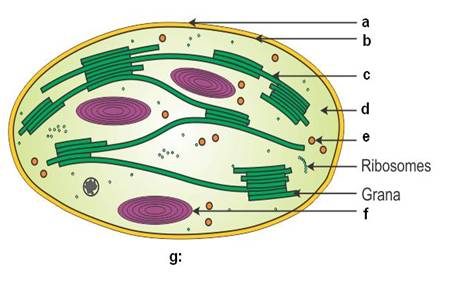 Name the structures labelled a, b, c, d, e, f and g in the given
diagram.
Name the structures labelled a, b, c, d, e, f and g in the given
diagram.
 Name the structures labelled a, b, c, d, e, f and g in the given
diagram.
Name the structures labelled a, b, c, d, e, f and g in the given
diagram. Solution
Outer membrane
Inner membrane
Stromal lamellae
Stroma
Lipid droplets
Starch granule
Electron micrograph of a section of the chloroplast
Q211. What is the saturation limit for CO2 in C3 and C4
plants?
Solution
The saturation values for CO2
are
C4 plants: At about 360 μlL−1
C3 plants: Above 450 μlL−1
Q212. Where does non-cyclic photophosphorylation occur? Describe the process
and explain why it is called so.
Solution
It occurs in the lamella of grana.
The process of non-cyclic photophosphorylation occurs as follows:
It begins with the absorption of light by P680
in PS II.
The molecule gets excited and gives out an energy-rich
electron which jumps into an orbit farther away from the atomic nucleus.
These electrons are picked up by primary
electron acceptors, which pass them into an electron transport system
consisting of cytochromes.
The electrons are then passed on to PS I.
Simultaneously, light of wavelength 700 nm is
absorbed by PS I and electrons are released by it.
These electrons are then transferred to another
electron acceptor, from where it is transferred to NADP+.
NADP+ is then reduced (NADPH + H+)
by electrons and protons from the photolysis of water.
Both ATP and NADPH are formed during this electron
flow.
Because the electrons given out by PS II do not return to PS II but
are replaced by those from water, the process is called non-cyclic
photophosphorylation.
Q213. Differentiate between cyclic and non-cyclic photophosphorylation.
Solution
Cyclic
photophosphorylation
Non-cyclic
photo-phosphorylation
The electrons given out by PS I (P700)
return to the same P700.
The electrons given out by PS II (P680)
do not return to it, but they are replaced by electrons from water.
It involves only PS I.
It involves both PS I and PS II.
There is no formation of NADPH or
photolysis of water.
It involves formation of NADPH and
photolysis of water.
No oxygen is liberated.
Oxygen is liberated.
Q214. 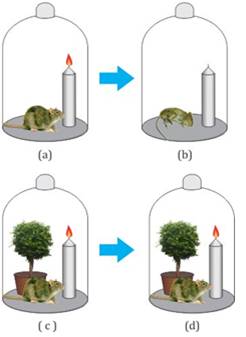 Who conducted this experiment?
Based on the experiment, which factor was shown
to be important for green plants?
What did he conclude from the experiment?
Who conducted this experiment?
Based on the experiment, which factor was shown
to be important for green plants?
What did he conclude from the experiment?
 Who conducted this experiment?
Based on the experiment, which factor was shown
to be important for green plants?
What did he conclude from the experiment?
Who conducted this experiment?
Based on the experiment, which factor was shown
to be important for green plants?
What did he conclude from the experiment?
Solution
Joseph Priestley.
The experiment showed the importance of air for
green plants.
Priestley concluded that green plants restore
to the air whatever burning candles and breathing animals remove.
Q215. Name the organisms used in the experiments for photosynthesis
performed by
a) Joseph Priestley
b) Cornelius van Niel
c) Engelmann
d) Jan Ingenhousz
Solution
Mouse and mint plant
Purple and green sulphur bacteria
Green algae
Cladophora
Aquatic plant
Q216. Photorespiration does not take place in C4 plants. Explain.
Solution
Photorespiration occurs due to the
oxygenase activity of RuBisCO. When the concentration of O2 is
high, RuBisCO binds to oxygen and carries out photorespiration. C4
plants have a mechanism of maintaining high CO2 concentration at
the enzyme site, thus photorespiration does not occur.
Q217. What are the absorption maxima for the reaction centres of PS I and PS
II?
Solution
The PS I reaction centre has an absorption maxima of 700 nm, and the PS
II reaction centre has an absorption maxima of 680 nm.
Q218. What is the possible reason for the occurrence of cyclic
photophosphorylation?
Solution
For the fixation of one molecule of CO2, 3 ATP and 2 NADPH
molecules are required; thus, in order to meet this difference in the number
of ATP and NADPH molecules, cyclic photophosphorylation occurs.
 ATP
ATP
Comments
Post a Comment